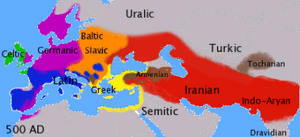Proto-Indo-European language facts for kids

The Proto-Indo-European language (PIE) is like the ancient grandparent of many languages spoken today. It's the language from which all the Indo-European languages grew. Think of it as the original language that later split into many different ones.
Scientists called linguists have studied how languages change over time. They used special methods to figure out what PIE might have sounded like. Even though no one ever wrote it down, it's one of the best-understood "proto-languages" (very old, unwritten languages).
Contents
Discovering This Ancient Language
Scientists have different ideas about when and where PIE was spoken. Many believe it was a single language that started to split apart around 3700 BC. That's a very long time ago!
The most popular idea about its origin is called the Kurgan hypothesis. This theory suggests that PIE began in the Pontic-Caspian steppe. This is a large grassy area in Eastern Europe.
How We Reconstruct PIE Sounds
Since PIE was never written, we don't have any old books or texts from it. So, how do we know anything about it? Linguists look at words in many different Indo-European languages today. They search for patterns and similarities.
For example, the word for 'water' in many languages sounds similar: Wasser in German, vatten in Swedish, udr in Sanskrit. By comparing these, linguists can guess what the original PIE word was. They use an asterisk (*) in front of words to show they are reconstructed, not actually found.
So, *wódr̥ means 'water', *ḱwṓn means 'dog', and *tréyes means 'three'. Many modern words come from these "proto-words" through regular sound changes. One famous example of these changes is called Grimm's law.
How PIE Sounds Were Made
Linguists believe PIE had a set of sounds, including vowels and consonants. These sounds are similar to what we hear in languages today.
- Short vowels: Sounds like 'a', 'e', 'i', 'o', 'u'.
- Long vowels: These were held longer, like 'ā', 'ē', 'ō'. A line over the letter (called a macron) shows it's a long vowel.
- Diphthongs: These are sounds made by combining two vowels, like 'ai' or 'ou'.
Word Stress and Pitch
PIE had something called a free pitch accent. This means that the stress or emphasis in a word could be on any syllable. It could even change for words that were related! Sometimes, just changing the pitch (high or low sound) could give a word a different meaning.
How PIE Words Were Built
PIE was an inflected language. This means that words changed their endings to show their job in a sentence. For example, a noun might have a different ending if it was the subject of a sentence compared to if it was the object.
Words in PIE were built from basic parts called roots. These roots had suffixes (endings) added to them. The main vowel in a root could also change in a regular way. This system of vowel changes is called ablaut.
You can see ablaut in English words like sing, sang, sung. The vowel changes, but the meaning is still related to singing. Another example is the noun song.
Building Complex Words
Many Indo-European languages are "synthetic." This means they often combine many small parts (called morphemes) into one long word. These morphemes can be put together to make very complex words.
For example, in German, the word Aufsichtsratsmitgliederversammlung means "Supervision + council + member + assembly." It's one long word made of many parts!
PIE probably used these methods a lot. Languages like English don't combine words as much now. But English came from Anglo-Saxon, which was more like German. You can still see hints of this in words like cranberry. The "cran-" part is a bit of an old word that doesn't exist on its own anymore.
Reconstructed Sample Texts
Because PIE was spoken so long ago, there are no real texts left. But scientists have tried to create example texts to show what PIE might have looked like. These are just educated guesses, but they help us understand the language better.
One famous example text that has been rewritten many times is by a linguist named Schleicher.
Schleicher's Version (1868)
Avis akvāsas ka
- Avis, jasmin varnā na ā ast, dadarka akvams, tam, vāgham garum vaghantam, tam, bhāram magham, tam, manum āku bharantam. Avis akvabhjams ā vavakat: kard aghnutai mai vidanti manum akvams agantam. Akvāsas ā vavakant: krudhi avai, kard aghnutai vividvant-svas: manus patis varnām avisāms karnauti svabhjam gharmam vastram avibhjams ka varnā na asti. Tat kukruvants avis agram ā bhugat.
Schleicher's version of PIE sounds a bit like Sanskrit, an ancient Indian language.
Hirt's Version (1939)
Owis ek’wōses-kʷe
- Owis, jesmin wьlənā ne ēst, dedork’e ek’wons, tom, woghom gʷьrum weghontm̥, tom, bhorom megam, tom, gh’ьmonm̥ ōk’u bherontm̥. Owis ek’womos ewьwekʷet: k’ērd aghnutai moi widontei gh’ьmonm̥ ek’wons ag’ontm̥. Ek’wōses ewьwekʷont: kl’udhi, owei!, k’ērd aghnutai vidontmos: gh’ьmo, potis, wьlənām owjôm kʷr̥neuti sebhoi ghʷermom westrom; owimos-kʷe wьlənā ne esti. Tod k’ek’ruwos owis ag’rom ebhuget.
Hirt's version used different ideas about the sounds of PIE.
English Translation of the Text
The Sheep and the Horses
- [On a hill,] a sheep that had no wool saw horses. One horse was pulling a heavy wagon. Another was carrying a big load. A third horse was carrying a man quickly. The sheep said to the horses: "My heart hurts me, seeing a man driving horses."
The horses replied: "Listen, sheep, our hearts hurt us when we see this: a man, our master, makes the wool of the sheep into a warm coat for himself. And the sheep has no wool!" After hearing this, the sheep ran away into the plain.
You might notice differences between the reconstructed texts. Some are just different ways of writing the same sound. But many differences come from different ideas about what PIE truly sounded like and how it was structured.
Related pages
See also
 In Spanish: Idioma protoindoeuropeo para niños
In Spanish: Idioma protoindoeuropeo para niños

